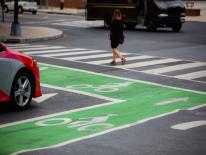
Addressing common concerns about DDOT's efforts to promote bicycle and pedestrian safety.
What is DDOT doing to educate people about pedestrian/bike safety?
Street Smart Campaign
Promotes safe behaviors by motorists, pedestrians, and cyclists through radio, newspaper, and transit advertising, as well as added law enforcement in conjunction with increased law enforcement.
Bicycle Ambassador
- Travels the city by bike to spread the word about bicycle safety with the help of the Washington Area Bicyclist Association (WABA).
- Attends workplace events on the topic and manages a crew of volunteer ambassadors.
Safe Routes to School
- Encouraging students and their parents to walk and bicycle to school.
- Improving safety for students who walk and bicycle to school.
Sidewalk Gap Program
- Filling all sidewalk gaps in the District of Columbia.
Adult Bicyclist Education
DDOT funds WABA’s adult bicycle education safety classes.
What about walking rules?
- Cross the street at a crosswalk, or if no crosswalk exists, at the intersection.
- Wait for the “Walk” signal before crossing.
- Yield to motor vehicles when crossing mid-block.
- Do not walk in the street if a sidewalk is provided.
- Do not walk while distracted by cell phones or other electronic devices.
What are the most important traffic laws I should know when bicycling in DC?
- Bicyclists traveling on roadways have all the general rights and duties of vehicle drivers.
- Helmet use is mandatory for cyclists under the age of 16. Helmet use is strongly recommended for all others.
- Cycling on sidewalks is permitted outside of the DC Central Business District. Cyclists must yield to pedestrians on sidewalks.
- A white headlight that is visible from 500 feet and a red reflector or taillight visible from 300 feet is required by law when riding at night.
- For more information, visit goDCgo.
As a driver, what should I know about bicycling and walking in DC?
- Vehicles turning right on red must yield to pedestrians in the crosswalk.
- Stop for pedestrians in the crosswalk.
- When turning right across a bike lane, check for cyclists, merge into the bike lane, and then execute your turn.
- When turning left or right, check for pedestrians and bicyclists.
- Bike lanes are reserved for bicyclists. Do not park or drive in bike lanes.
- Unless signage indicates otherwise, bicyclists are allowed on all streets and sidewalks outside the DC Central Business District.
Additional Information
What are the most common crashes, and how can I avoid them happening to me?
- One of the most common bicycle crashes is known as the right hook, when a right-turning motorist hits a bicyclist traveling straight through the intersection. In this case, the bicyclist has the right of way. Motorists should let bicyclists clear the intersection before beginning their turn. As a precaution, bicyclists can look over their left shoulder to check for cars before traveling through an intersection.
- A less common but potentially harmful crash is known as dooring, whereby a motorist in a parked car opens the door and hits a bicyclist. Here too, the motorist is at fault. Motorists must check for all traffic before opening the door.
- Tips, tricks, and how-tos - Tips on getting around safely.
I’m nervous about riding a bike through the busy streets of DC. How can I become more comfortable with riding in the city?
- One way to get acclimated to riding is to practice during less busy times. Weekends are great for trying out routes and gaining confidence on the road.
- Additionally, WABA offers free City Cycling classes to help improve and enhance biking skills.
I don’t know how to ride a bike, but I would love to learn. Are there any learn-to-ride programs?
What is DDOT doing to enforce pedestrian and bike laws and reduce aggressive driving?
The Metropolitan Police Department is responsible for enforcing traffic rules. DDOT funds special MPD enforcement initiatives such as the Street Smart Campaign.